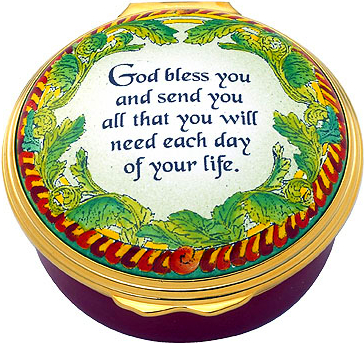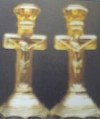Carnival Glass 101 | home Quick Reference to Carnival Glass Patterns
Introduction · How Carnival Was Made · Glass Process · Early Makers · Finding Carnival · Colors · Carnival Glass Edges · Buying Carnival · Carnival Terms · Glass Terms · Reference Books · What is This? · FAQ · Sharing Carnival · Links · Closing
Carnival Terms
Carnival Terms
A Glossary of Carnival Glass Terms
Advertising - Plates of small or large size, as well as bowls with writing or printing applied to advertise a product or business.
Base Glass - This refers to color of the glass itself, not the iridescent spray.
Bonbon - A two-handled dish with or without a stem.
Chiggers - Same as flea bites (just try to imagine a flea biting the glass, the bite would not be very big).
Chip - is self-explanatory, a missing piece of glass, hopefully small.
Commemorative - Plates, bowls, bells with writing applied to lend prominence to some historic event or dedication ceremony.
Comport - Same as a compote.
Compote - a small stem-based bowl
Crack - is obvious damage.
Damage - Constitutes breakage, chips, cracks or excessive flaws.
Edges - Candy ribbon, 3 and one, tight crimped, saw tooth, scalloped, pie crust, ruffled, or fluted.
Electric - Extremely pronounced or vibrant coloration, brighter than usual.
Exterior - Back or underside of the piece. Example: Basket weave design-found on many Northwood pieces.
Flat - Flat is flat, overall, Fenton produced more flat plates than other companies.
Flea bite or Chigger - indicates a very small chip or flake on the piece.
Footed - Can be three spatula feet, a round dome foot, set at center of bowl/plate, three small curled feet, 3 straight small ball-type feet.
Handles - NEVER pick up an old pitcher by its handle. They have been known to come off in the process.
Ice Cream Shape - Round
Iridescent quality - even distribution of the applied color, allowing for no bare spots, or wear on the surface will offer the best piece available at top price.
Jack in Pulpit - One side turned up, the other downward, as in vases and compotes.
Marie or Collar-base - a narrow, ¼” circular rim used to set or stabilize a piece in the sitting position.
Marked - Marked carnival usually means newer carnival with the exception of Northwood but, ALL Northwood pieces are NOT marked with an N within a circle. NONE of the Fenton carnival glass produced prior to 1940 were stamped with Fenton inside the oval. There are NO early Imperial pieces marked IG or LIG. Early Dugan and Millersburg carnival glass was NOT marked with a trademark.
Nappy - is a spade-shaped one-handled shallow dish.
Pitchers - Found in cream, milk, or water sizes.
Plate - difference between a bowl and a plate is all in how tall they are, with a plate being no higher than 2 inches from bottom to the highest top point.
Radium Finish - High gloss, very shiny. A process that was developed by Millersburg. Term: Radium technique was never applied to Imperial products (in writing). However, appearance is very much the same as seen on some Millersburg.
Repaired - Clear glue of various types have been used to replace a point, fill a chip, etc. Usually, these places are obvious to the naked eye, but when it is suspected, a black light should reveal the extent of repair. This will, of course, adjust the price of any piece downward.
Ruffled - (can be either 6 or 8, 10, or 12) ruffles to a carnival glass item.
Satin Finish - Soft glow, low gloss.
Scoop - Commonly referred to in describing Northwood plates. (Not a very flat plate)
Shapes - compote, bowls, nappy, bonbon,, vases, pitchers, tumblers, mugs, plates, sweet meat, pin tray, pickle dish, creamer and sugar to name a few. Edges can be ice cream shaped (round), ruffled (can be either 6 or 8, 10,or 12), pie crust edge, 3 and one edge, candy ribbon edge.
Square - refers to tight candy ribbon edge coerced into that shape.
Stippled - An application of intensely close tiny indentations, usually within a pattern…….thought to have been a method of extending use of the mold, following heavy use, and slight damage from particles of hot glass which could no longer be removed in the usual cleaning process. Stippling is found both on the interior and exterior of pieces.
Straw mark - is actually a “sheer mark”, where sheers were literally used to cut the molten glass off, when enough had gone into the mold for filling. Some pieces display that mark more prominently. It does not constitute damage, but is simply a process of the manufacture.
Surplus glass - Used to describe excess or a small amount of hot glass which seeped through to surface at the mold line, along edge or where two sections of mold came together.
Tool mark - were left sometimes when the apple wood paddles used for final shaping of a piece created an indentation into the cooling glass. (We have actually removed a tiny sliver of that wood from one piece we have owned, thereby leaving a small space in the glass.)
Variant - referred to when perhaps an original mold wore out. In chiseling a replacement mold for further production, some variances in the former pattern took place.
Webbing - Same as surplus glass.

back to Carnival Glass 101
Should you care to contact the Frys, their email address is:
Search Carnival Glass 101
Our other sites you may enjoy:
Everything you EVER wanted to know about Indiana Glass
Great Reference for Newer Carnival Glass.
Complete Glassware Catalogs Available to Download
Questions? Comments? Suggestions? Broken Links? Corrections?
Your Friendly Webmaster is here to help!
